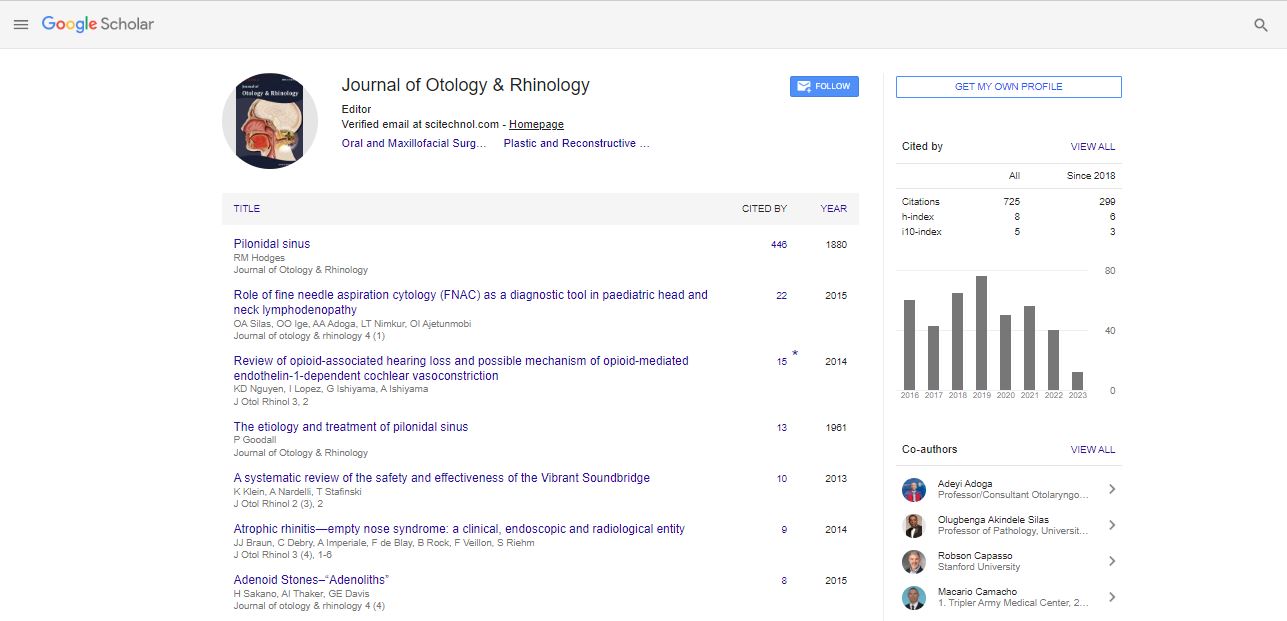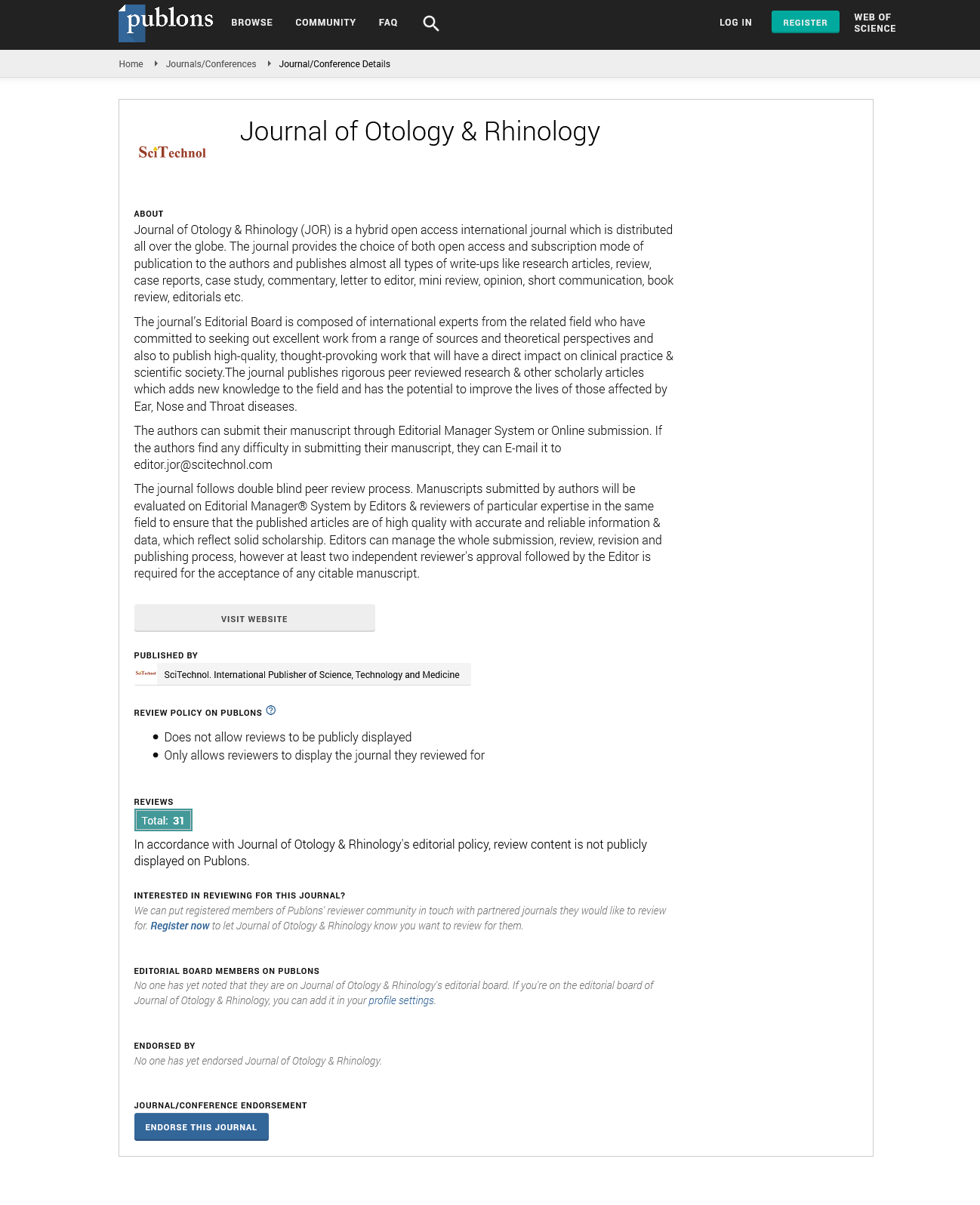Opinion Article, J Otol Rhinol Vol: 12 Issue: 2
Chemosensory Disorders: Understanding Taste and Smell Dysfunction and Its Impact on Health and Quality of Life
Bergmann Nicole*
Department of Neurology, University of Tubingen, Tubingen, Germanys
*Corresponding Author: Bergmann Nicole
Department of Neurology, University of Tubingen, Tubingen, Germany
Email: nicolebergmann@gmail.com
Received date: 20 February, 2023, Manuscript No. JOR-23-95109;
Editor assigned date: 22 February, 2023, PreQC No. JOR-23-95109 (PQ);
Reviewed date: 08 March, 2023, QC No. JOR-23-95109;
Revised date: 15 March, 2023, Manuscript No. JOR-23-95109 (R);
Published date: 22 March, 2023, DOI: 10.4172/2324-8785.100054
Citation: Joanna G (2023) Chemosensory Disorders: Understanding Taste and Smell Dysfunction and Its Impact on Health and Quality of Life. J Clin Image Case Rep 12:2.
Description
Taste and smell are two critical senses that play a significant role in daily lives, including enjoyment of food, perception of flavors, and detection of potential dangers. In this section, we will delve into the anatomy and physiology of taste and smell, including the underlying mechanisms that allow us to experience these sensations.
The anatomy of taste: Taste buds, located on the tongue and other areas of the mouth, are responsible for detecting different tastes, such as sweet, sour, bitter, salty, and umami. These taste buds contain specialized cells that respond to specific taste stimuli and send signals to the brain for interpretation.
The anatomy of smell: The olfactory system, located in the nasal cavity, is responsible for sense of smell. Olfactory receptors detect odor molecules in the air and send signals to the brain for processing. The sense of smell is closely interconnected with taste, and together, they create perception of flavor.
Types and causes of chemosensory disorders
Chemosensory disorders can occur due to various factors, including viral infections, head trauma, certain medications, nutritional deficiencies, and other underlying medical conditions. In this section, we will explore the different types of chemosensory disorders and their potential causes.
Hypogeusia and hyposmia: Hypogeusia refers to a reduced ability to taste, while hyposmia refers to a reduced ability to smell. These conditions can result from various factors, such as viral infections, head trauma, certain medications, and nutritional deficiencies. Hypogeusia and hyposmia can have a significant impact on an individual's ability to enjoy food and perceive flavors, leading to changes in their dietary habits and quality of life.
Ageusia and anosmia: Ageusia refers to the complete loss of taste, while anosmia refers to the complete loss of smell. These conditions can be caused by factors such as viral infections, head trauma, neurodegenerative diseases, and genetic conditions. Ageusia and anosmia can severely affect an individual's quality of life, as they may struggle to enjoy food and perceive flavors or odors in their environment.
Dysgeusia and dysosmia: Dysgeusia refers to a distorted sense of taste, while dysosmia refers to a distorted sense of smell. These conditions can result in altered perceptions of taste or smell, where things may taste or smell differently than they should. Dysgeusia and dysosmia can be caused by factors such as infections, medications, hormonal changes, and other underlying medical conditions.
Diagnosis and management of chemosensory disorders
Diagnosing chemosensory disorders: Diagnosing chemosensory disorders can involve a comprehensive evaluation by a healthcare professional, such as an otolaryngologist, neurologist, or a taste and smell specialist. The evaluation may include a detailed medical history, a physical examination, and specialized tests to assess taste and smell function, such as taste strips, smell identification tests, and imaging studies.
Management of chemosensory disorders: The management of chemosensory disorders depends on the underlying cause and severity of the condition. In some cases, addressing the underlying medical condition, such as treating an infection or adjusting medications, may help restore taste and smell function. However, in many cases, chemosensory disorders may be chronic or irreversible.
 Spanish
Spanish  Chinese
Chinese  Russian
Russian  German
German  French
French  Japanese
Japanese  Portuguese
Portuguese  Hindi
Hindi 


